|
|
Gill Disorders
|
Symptoms
|
|
Cause
|
|
Treatment and Links
|
| A). The gill filaments are light,
having lost color |
 |
Has the pH changed?
Is chlorine in the water?
Is ammonia in the water? |
 |
Establish optimum water values. Check pH,
and Chlorine. Use
Aqua Gold. |
 |
|
 |
|
|
| |
|
The fish can be affected by a Kidney Disease |
 |
Treat fish with
TMP Sulfa -or-
Erythromycin. |
|
| B). Small white objects (1 to 1.5mm)
are attached to the gill filaments. They hold very tightly |
 |
Gill Crustaceans |
 |
Treat the fish with
De-Los and
Methylene Blue. |
 |
|
| C). Blood-red worms are visible on
the inside surface of the operculum (gill plate), but usually
only in pond fish |
 |
The fish are affected with blood worms
(Philometra spp) |
 |
Treat the fish with
De-Los |
 |
|
| D). Light flecks appear on the
gills. The gill filaments are necrotic at this spot |
 |
Eggs of the blood fluke Sanguinicola spp are
involved. If fungal hyphae are seen in the slides, then
gill rot is involved |
 |
Treat with a bath in
Acriflavine Neutral. |
 |
|
| E). Are the gills flecked with
grey-white. Do the filaments keep falling out? |
 |
Branchiomyces fungal gill rot |
 |
Treat with
Forma-Green |
 |
|
| F). Cotton-like threads grow on the
operculum (gill plate) or gill filaments |
 |
Saproglenia fungal infection |
 |
Treat with:
Forma-Green -or-
Acriflavine Neutral. |
 |
|
| G). Breathing is rapid, one or both
opercula (gill plates) are open, and the fish rubs itself around
the gills. The fish hangs below the surface and gulps for
air |
 |
The fish is affected with gill worms or gull
flukes |
 |
Treat with: Praziquantel
for marine fish or
De-Los for freshwater fish |
 |
|
| H). The gill filaments appear
slightly cloudy, even whitish on the surfaces |
 |
Your fish are affected by a Protozoan Infection |
 |
Treat with:
Metronidazole and
Methylene Blue. |
 |
|
| I). White dots appear on the gill
filaments. The dots measure 0.5mm in freshwater fish and
to 1mm in marine fish |
 |
An Ichthyophthirius or Cryptocaryon disease is
beginning to spread |
 |
Treat with:
Forma-Green -or-
Copper Sulfate. If marine cryptocaryon is resistant to
the above treatments, use Quinine Sulfate |
 |
|
| J). Small, white modules appear on
the gill filaments and cannot be removed |
 |
Most likely, sporozoan cysts |
 |
No suitable treatment known. |
 |
|
| K). The gill filaments swell up,
becoming slimy and stick together |
 |
Chemical factors may be involved |
 |
Change the water and filter over fresh,
activated charcoal. |
 |
|
 |
|
|
| |
|
Are the fish affected with gill worms or flukes? |
 |
Treat fish with
Praziquantel in marine tanks -or-
De-Los. in freshwater aquariums & ponds. |
| |
 |
|
|
| |
The fill filaments break up from the tip on.
The cartilage remains a little longer. Bacterial
gill rot caused by Columnaris bacteria |
 |
Treat the fish with
Acriflavine Neutral |
|
| L). The gill filaments are very pale
pink |
 |
The fish is anemic, which often occurs following
severe kidney damage or infection by blood flagellates |
 |
No suitable treatment known. |
| |
|
Home
ı
Articles ı
Prevention ı
Fish
Diseases ı
About Us ı
Contact Us ı
Terms of Use ı
Privacy Policy ı
Shipping ı
Products |

